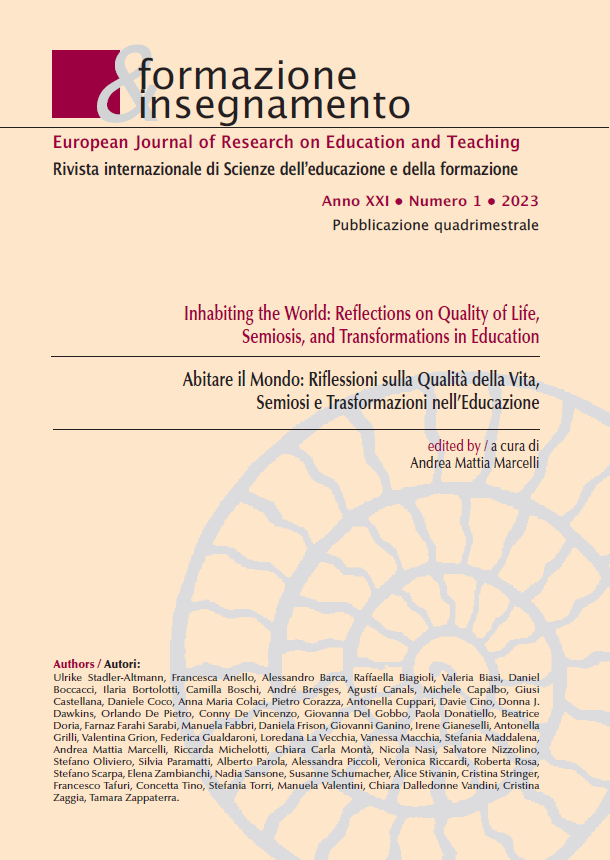Culture of difference and diversity through corporeality
DOI:
https://doi.org/10.7346/-fei-XXI-01-23_33Keywords:
Culture, Difference, Diversity, Analogical body, Language, Education, Performative artsAbstract
Culture may seem like a simple word, but putting it into action can be challenging, especially when we consider the concepts of difference and diversity. The complexity deepens when we incorporate the word "body" alongside culture, diversity, and difference. These terms appear straightforward in everyday language, yet they encompass various meanings that are not always easily reconcilable. This paper aims to promote the understanding of differences among education and care professionals, emphasizing the role of nonverbal communication as a facilitator of interactions between individuals, environments, and personal experiences. While it is easy to conceptualize these ideas, implementing effective practices remains a challenge despite progress and research. The body's development accompanies us throughout our lives, particularly during formative stages, as well as adulthood and old age. Our body is intricately tied to our identity, serving as our "identity card" in the world. Each body and personality are unique, and it is this uniqueness that defines and distinguishes us. Therefore, we must place significant emphasis on the powerful contribution of nonverbal language in the education, growth, and lives of individuals, regardless of their physical, psychological, social, or cultural conditions.
References
Agazzi, E. (1969). Temi e problemi di filosofia della fisica. Milano: Manfredi.
Booth, T., & Ainscow, M. (2002). Index for Inclusion: developing learning and participation in schools. CSIE. Retrieved December 30, 2022, from http://www.csie.org.uk/resources/inclusion-index-explained.shtml
Bruner, J. S. (2002). La cultura dell’educazione. Bari: Laterza.
Canevaro, A. (2006). Le logiche del confine e del sentiero. Trento: Erickson.
Cottini, L. (2019). Vincere le sfide con la sindrome di Down. Roma: Anicia.
Csordas, T. J. (1994). Embodiment and Experience: The Existential Ground of Culture and Self. Cambridge: University Press.
D’Alonzo, L. (2020). Esistono anche gli alunni con disabilità [Video file]. Retrieved December 30, 2022, from https://www.youtube.com/watch?v=a1bweKD71RM
De Amicis, E. (1971). Amore e ginnastica, nota introduttiva di Italo Calvino. Centopagine, 6, Torino: Einaudi.
Demetrio, D. (1995). Raccontarsi. L’autobiografia come cura di sé. Milano: Raffaello Cortina.
Demetrio, D. (Ed.) (2003). Per una didattica dell’intelligenza. Il metodo autobiografico nello sviluppo cognitivo. Milano: Franco Angeli.
Floridi, L. (2020). Il verde e il blu. Milano: Raffaello Cortina.
Foucault, M. (1976). Sorvegliare e punire, nascita della prigione. Torino: Einaudi.
Frabboni, F. (2015). La scuola del bambino di Maria Montessori e la scuola a nuovo indirizzo di Ciari e Malaguzzi. In M. Baldacci, F. Frabboni, & M. Zabalza (Eds.), Maria Montessori e la scuola d’infanzia a nuovo indirizzo. Bergamo: Zeroseiup.
Freire, P. (2017). Le virtù dell'educatore. Una pedagogia dell'emancipazione. Bologna: Lampi EDB.
Gaspari, P. (2014). Pedagogia speciale e “BES”. Roma: Anicia.
Le Boulch, J. (1975). Verso una scienza del movimento umano. Roma: Armando.
Le Breton, D. (1990). Antropologia del cuerpo y modernidad. Buenos Aires: Nueva Visión.
Malaguti, E. (2012). Relazione. La riduzione dell’handicap: il ruolo della scuola. Retrieved December 30, 2022, from http://integrazionescolastica.it/upload/art572/riduzione_handicap_ruolo_scuola.pdf
Pasolini, P. P. (1965). Comizi d’Amore. Alfredo Bini: Arco Film.
Quaranta, I. (2012). La trasformazione dell’esperienza. Antropologia e processi di cura. Antropologia e Teatro. Rivista di Studi, 3(3). https://doi.org/10.6092/issn.2039-2281/3187
Rivoltella, P. C. (2022). La comunicazione. Dizionario di scienze e tecniche. Retrieved December 30, 2022, from https://www.lacomunicazione.it/voce/home-page/
Tucci, G. (1992). Storia della filosofia indiana. Milano: Tea.
Williams, R. (1980). Marxismo y Literatura. Barcelona: Península.
Downloads
Published
How to Cite
Issue
Section
License
Copyright (c) 2023 Manuela Valentini, Paola Donatiello

This work is licensed under a Creative Commons Attribution 4.0 International License.
Formazione & insegnamento is distributed under Attribution 4.0 International (CC BY 4.0).
For further details, please refer to our Repository & Archiving Policy, as well as our Copyright & Licensing Terms.





